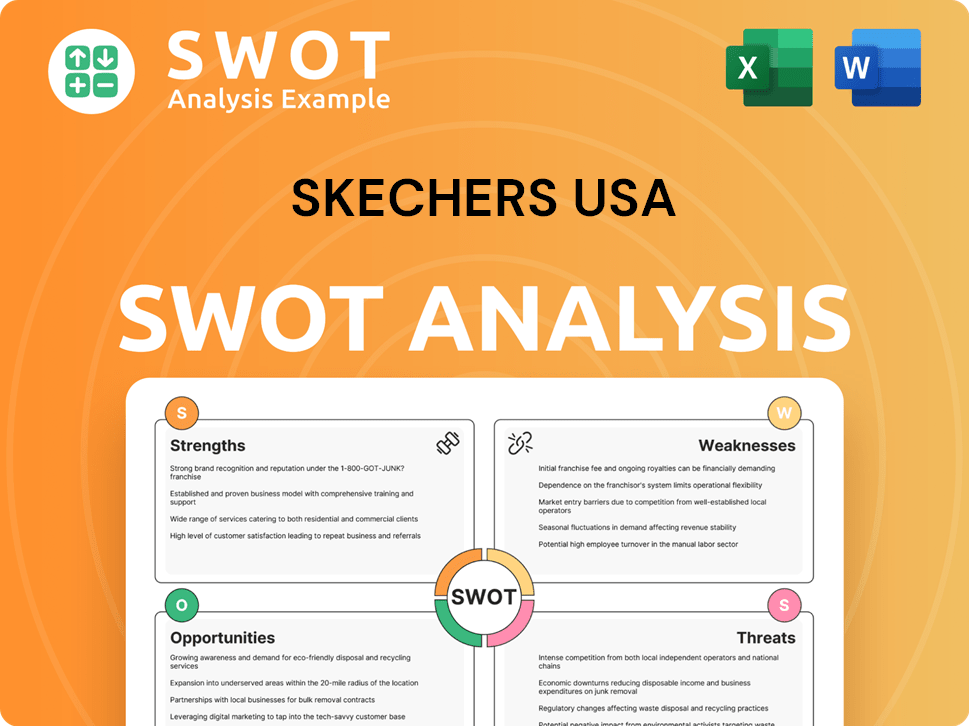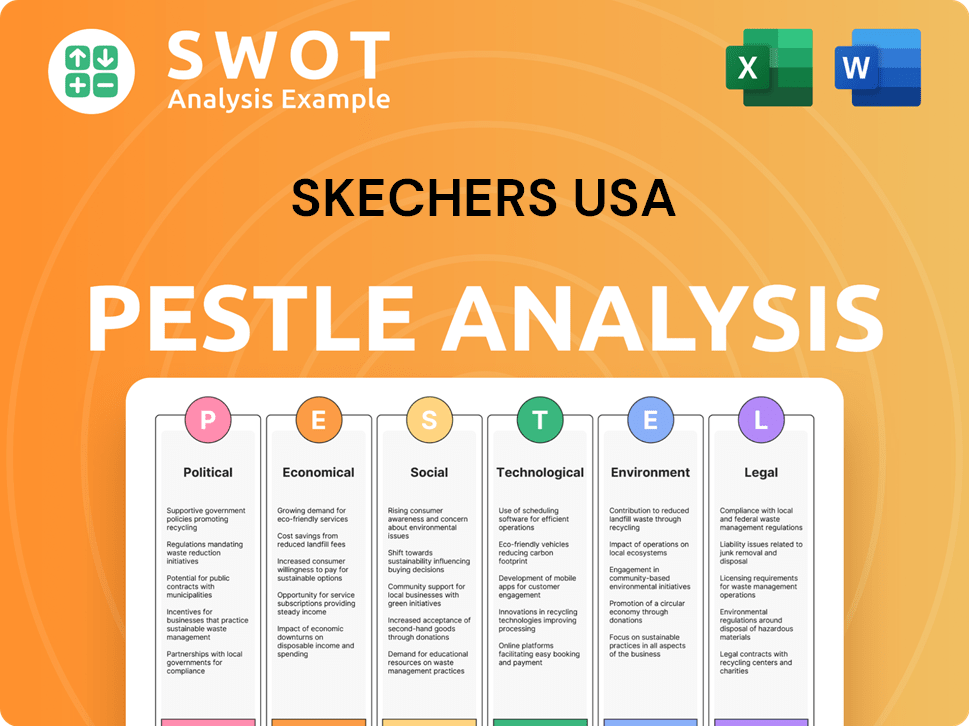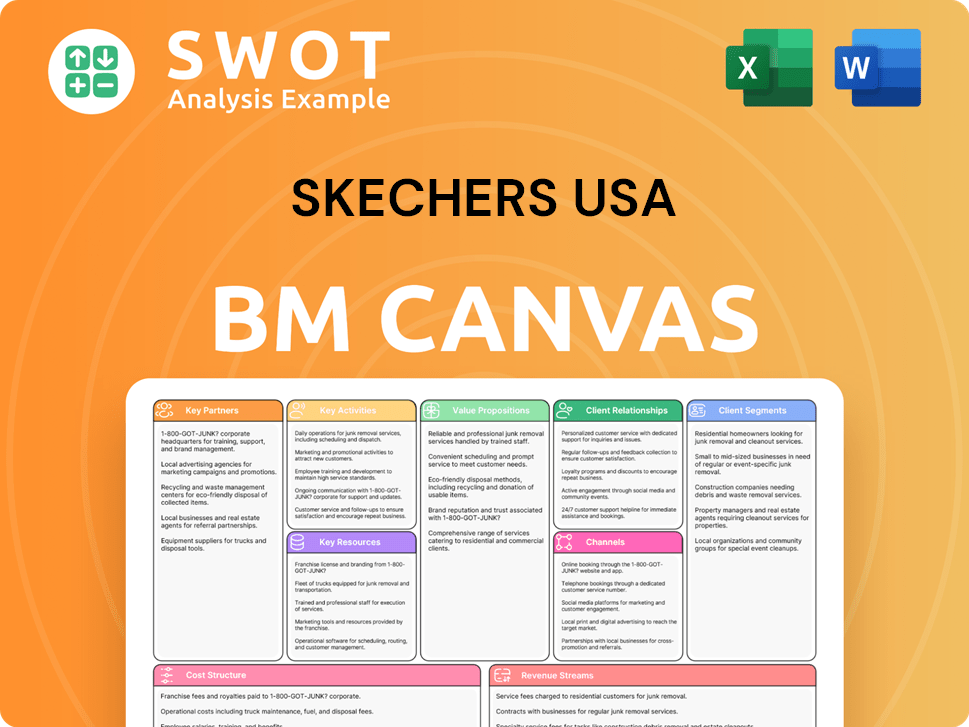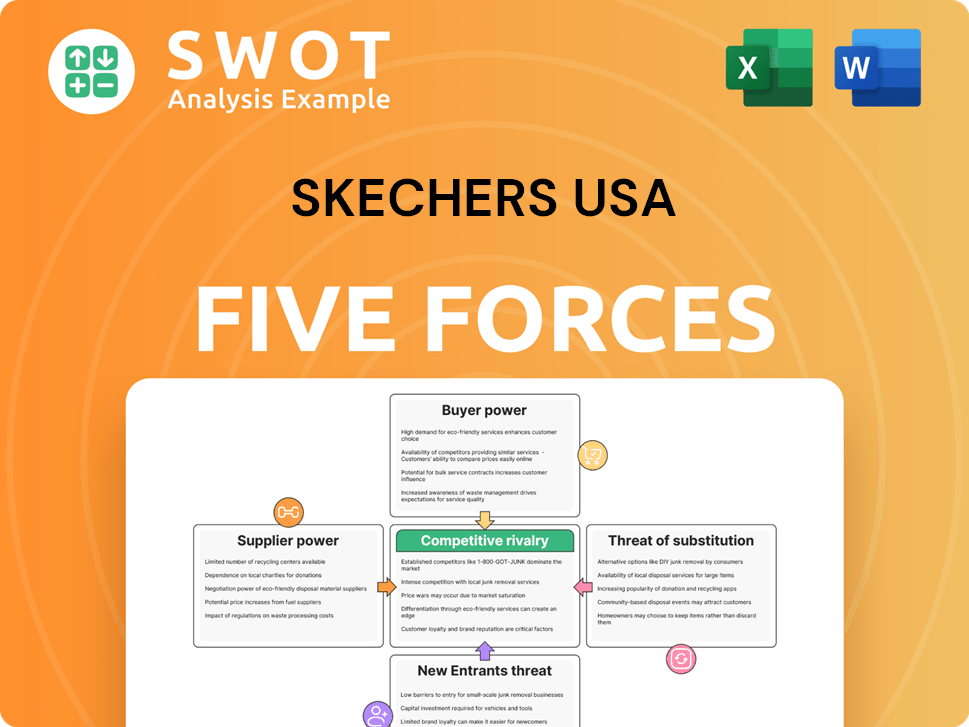Skechers USA Bundle
How Did Skechers Become a Global Footwear Giant?
Journey back to 1992, when Robert Greenberg launched Skechers USA, Inc., with a vision that would redefine casual footwear. From its humble beginnings in Manhattan Beach, California, this Skechers USA SWOT Analysis reveals the strategic brilliance behind the brand's rise. Discover how Skechers evolved from a niche player to a dominant force in the global market, captivating consumers with innovative designs and comfort technologies.

The Skechers company background is a testament to adaptability and strategic foresight, transforming from a company focused on utility boots to a lifestyle and performance footwear leader. Understanding the Skechers timeline, including its early years and key milestones, offers valuable insights into its sustained success. Explore the Skechers history, including its marketing history and product evolution, to uncover the secrets behind its remarkable growth and current market position.
What is the Skechers USA Founding Story?
The story of the Skechers USA, Inc. begins on January 2, 1992. Robert Greenberg, the founder, brought with him a wealth of experience from his prior venture, L.A. Gear. This background was instrumental in shaping Skechers' initial direction and understanding of the footwear market.
Greenberg's vision was to fill a gap in the casual footwear market, focusing on stylish, comfortable, and accessible shoes. He aimed to cater to a broad demographic, especially those embracing the casual wear trend. The company's early days were marked by a focus on utility-style boots and casual shoes, targeting a youthful, fashion-conscious consumer base.
The name 'Skechers' itself has an interesting origin, inspired by Greenberg's children's playful description of restless kids. Initial funding came from Greenberg's personal resources and early sales, allowing for focused product development and market testing. Greenberg's expertise in manufacturing, marketing, and distribution was pivotal in establishing the company and navigating the initial challenges. For more insights, explore the Marketing Strategy of Skechers USA.
Skechers was founded in 1992 by Robert Greenberg, who previously founded L.A. Gear, identifying a market opportunity in casual footwear.
- Skechers history started with a focus on utility-style boots and casual shoes.
- The company's early success was fueled by Greenberg's experience and personal investment.
- The name 'Skechers' was inspired by a playful term used by Greenberg's children.
- The initial target market was the youthful, trend-conscious consumer.
Skechers USA SWOT Analysis
- Complete SWOT Breakdown
- Fully Customizable
- Editable in Excel & Word
- Professional Formatting
- Investor-Ready Format

What Drove the Early Growth of Skechers USA?
The early growth of the Skechers USA company was marked by rapid expansion and strategic market penetration. Following its establishment in 1992, the company quickly diversified its product lines, moving beyond its initial focus. This period saw the brand establishing a strong foothold in the footwear market through innovative product launches and targeted marketing efforts.
The
The company established its headquarters in Manhattan Beach, California. International distribution began in the late 1990s, recognizing the global potential for its footwear. Skechers went public in 1999, which provided capital for further expansion and product development.
Skechers invested heavily in marketing and celebrity endorsements to solidify its brand image. This strategy helped the company reach a wider audience and differentiate itself from competitors. The company's ability to quickly identify and respond to fashion trends was a crucial factor in its early success.
The company successfully carved out a niche between athletic performance brands and traditional casual footwear. The IPO in 1999 was a significant financial milestone, providing resources for growth. The competitive landscape included established players like Nike and Adidas, as well as numerous smaller brands.
Skechers USA PESTLE Analysis
- Covers All 6 PESTLE Categories
- No Research Needed – Save Hours of Work
- Built by Experts, Trusted by Consultants
- Instant Download, Ready to Use
- 100% Editable, Fully Customizable

What are the key Milestones in Skechers USA history?
The Skechers USA company's journey, from its inception to its current global presence, is marked by significant milestones. The Skechers history reveals a strategic evolution, adapting to market demands and consumer preferences. The Skechers brand has consistently innovated, expanded its product lines, and broadened its market reach.
| Year | Milestone |
|---|---|
| 1992 | Skechers is founded by Robert Greenberg, initially focusing on utility-style boots and skate shoes. |
| 1990s | The company expands its product line to include a variety of footwear styles, targeting diverse consumer segments. |
| 2000s | Skechers launches its marketing campaigns featuring celebrity endorsements, significantly boosting brand visibility. |
| Early 2010s | Introduction of Memory Foam footwear, revolutionizing comfort and becoming a core feature. |
| 2010s | The company expands globally, particularly in China, and diversifies its product portfolio. |
| 2020s | Skechers continues to innovate, focusing on comfort and performance, and adapting to changing consumer trends. |
Skechers shoes have consistently introduced innovations to meet evolving consumer needs. A groundbreaking innovation was the introduction of its Memory Foam footwear in the early 2010s, which revolutionized comfort in casual and athletic shoes. The company has also developed its Skechers GOwalk and GOrun performance lines, expanding its market appeal.
This technology, introduced in the early 2010s, significantly enhanced the comfort of Skechers shoes, becoming a key differentiator. This innovation helped Skechers USA to attract a wider customer base.
The development of the GOwalk and GOrun performance lines expanded the brand's appeal beyond lifestyle footwear. These lines catered to consumers seeking athletic and performance-oriented shoes.
Skechers has secured numerous patents for its comfort technologies, reinforcing its commitment to innovation. This focus on proprietary technology has helped to maintain its competitive advantage.
Partnerships with celebrities like Tony Romo and Willie Nelson have amplified the brand's visibility and appeal. These endorsements have broadened Skechers' reach to various consumer demographics.
Skechers has diversified its product offerings, including casual footwear, performance shoes, and apparel. This diversification has helped the company to cater to a wider range of consumer preferences.
The company's expansion into international markets, particularly China, has been a key growth strategy. This strategy has increased the company's revenue streams.
Skechers has faced several challenges throughout its history, including market downturns and competitive threats. A notable challenge was a lawsuit regarding its 'Shape-ups' toning shoes in the early 2010s, which led to a significant settlement. The company has consistently adapted to changing consumer preferences, evidenced by its strong performance during the COVID-19 pandemic.
The lawsuit and subsequent settlement regarding the 'Shape-ups' toning shoes required a re-evaluation of marketing strategies. This experience highlighted the importance of substantiated product claims.
Skechers has navigated various market downturns, requiring strategic adjustments to maintain profitability. These adjustments have included cost-cutting measures and product line optimization.
The footwear market is highly competitive, requiring continuous innovation and brand differentiation. Skechers has addressed these threats through product diversification and strategic marketing.
While not common, product failures have prompted swift adaptation and strategic shifts. These adaptations have included discontinuing underperforming products and refocusing on core strengths.
Skechers demonstrated resilience during the COVID-19 pandemic, with its comfortable and casual footwear resonating with consumers. This period highlighted the importance of adapting to changing consumer behavior.
Skechers has managed supply chain disruptions through diversification and strategic partnerships. This has helped the company to maintain its production and distribution capabilities.
To learn more about the company's journey, you can explore a detailed analysis of the Skechers timeline and its strategic moves in this article.
Skechers USA Business Model Canvas
- Complete 9-Block Business Model Canvas
- Effortlessly Communicate Your Business Strategy
- Investor-Ready BMC Format
- 100% Editable and Customizable
- Clear and Structured Layout

What is the Timeline of Key Events for Skechers USA?
The Skechers USA story began in 1992 when Robert Greenberg founded the company in Manhattan Beach, California, marking the start of the
| Year | Key Event |
|---|---|
| 1992 | Robert Greenberg founded Skechers USA, Inc. in Manhattan Beach, California. |
| 1993 | The brand introduced its first line of utility boots. |
| 1995 | Skechers expanded into women's footwear with the 'Skechers Sport' line. |
| 1998 | The 'Skechers Kids' collection was launched, targeting the children's market. |
| 1999 | Skechers became a publicly traded company on the New York Stock Exchange (NYSE: SKX). |
| 2000s | Significant international distribution expansion and the establishment of global retail stores occurred. |
| 2009 | Introduction of Skechers Shape-ups toning shoes, leading to rapid sales growth. |
| 2011 | Skechers GOrun and GOwalk performance lines were launched, marking a shift into athletic footwear. |
| 2013 | Introduction of Skechers Memory Foam, a key comfort technology. |
| 2015 | Skechers surpassed Adidas as the second-largest athletic footwear brand in the U.S. by market share for a period. |
| 2020 | The company navigated the challenges of the COVID-19 pandemic, adapting to increased demand for comfortable home-based footwear. |
| 2023 | Skechers reported record annual sales of $8.00 billion, a 7.5% increase year-over-year. |
| 2024 | The company continues global expansion, focusing on direct-to-consumer channels and key international markets. |
Skechers is focusing on expanding its presence in emerging markets. The company is increasing its direct-to-consumer channels to enhance customer engagement. This strategy is expected to drive growth by reaching a wider audience and improving sales channels.
The company aims to achieve $10 billion in annual sales by 2026. This growth will be fueled by diverse product offerings and global expansion. Skechers is investing in e-commerce platforms and supply chain capabilities to support this goal.
Skechers continues to invest in comfort and performance technologies. They are also responding to the growing demand for sustainable products. The company is exploring eco-friendly materials and personalized offerings to meet consumer needs.
The company is adapting to trends like the demand for sustainable products. They are also focusing on providing personalized experiences. Leadership emphasizes product innovation and aggressive market penetration to stay competitive.
Skechers USA Porter's Five Forces Analysis
- Covers All 5 Competitive Forces in Detail
- Structured for Consultants, Students, and Founders
- 100% Editable in Microsoft Word & Excel
- Instant Digital Download – Use Immediately
- Compatible with Mac & PC – Fully Unlocked

Related Blogs
- What is Competitive Landscape of Skechers USA Company?
- What is Growth Strategy and Future Prospects of Skechers USA Company?
- How Does Skechers USA Company Work?
- What is Sales and Marketing Strategy of Skechers USA Company?
- What is Brief History of Skechers USA Company?
- Who Owns Skechers USA Company?
- What is Customer Demographics and Target Market of Skechers USA Company?
Disclaimer
All information, articles, and product details provided on this website are for general informational and educational purposes only. We do not claim any ownership over, nor do we intend to infringe upon, any trademarks, copyrights, logos, brand names, or other intellectual property mentioned or depicted on this site. Such intellectual property remains the property of its respective owners, and any references here are made solely for identification or informational purposes, without implying any affiliation, endorsement, or partnership.
We make no representations or warranties, express or implied, regarding the accuracy, completeness, or suitability of any content or products presented. Nothing on this website should be construed as legal, tax, investment, financial, medical, or other professional advice. In addition, no part of this site—including articles or product references—constitutes a solicitation, recommendation, endorsement, advertisement, or offer to buy or sell any securities, franchises, or other financial instruments, particularly in jurisdictions where such activity would be unlawful.
All content is of a general nature and may not address the specific circumstances of any individual or entity. It is not a substitute for professional advice or services. Any actions you take based on the information provided here are strictly at your own risk. You accept full responsibility for any decisions or outcomes arising from your use of this website and agree to release us from any liability in connection with your use of, or reliance upon, the content or products found herein.